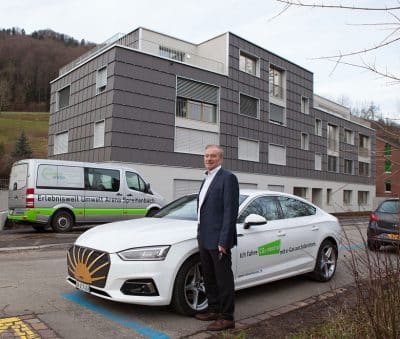A completely energy-independent home: a vision that some customers feel has so far not been easy to implement. What could change their opinion is the world’s first-ever off-grid multifamily property in Brütten, near Zurich in Switzerland. Since 2016, it has provided tenants with on-site gas and electricity, for both apartments and vehicles. This kind of energy-independent lifestyle has been made possible by combining a PV system, a heat pump and an electrolyzer, which uses a fuel cell to store electric power. As early as this year, Umwelt Arena Spreitenbach, the organization that owns the off-grid building, announced a follow-on project to “show that everyone can replicate our success.”
The aim of Umwelt Arena’s chairman, housing developer Walter Schmid, co-owner of W. Schmid, was to design and erect a multi-unit property that could be independent of public electricity and gas services (see fig. 1).
Schmid mainly used PV technology to achieve his goal. He built a large rooftop solar installation, made up of monocrystalline cells, and added thin-film modules to the facade. Considering Switzerland has hardly enough sunshine in winter but a relatively long heating season, the system needed efficient and cross-linked energy storage units.
…
Electricity is either consumed immediately or stored via the electrolyzer. When required, that is, when the sun does not come out, a fuel cell unit by Proton Motor will produce electric power from the hydrogen, and the waste heat from power conversion will be used for heating or directed to thermal storage. Because of the fluctuating voltage at the outlet of the fuel cell unit, the developer installed an Aradex DC-DC converter to raise it from between 50 and 100 volts to 700 volts to guarantee trouble-free operation. This adapter is also connected to an accumulator, which offers short-term power supplies that last two to three days. Overall, the system shows an effective combination of short- and long-term storage options. Besides household appliances, it feeds electricity into a charging station for electric cars.
…
Cut off from the electrical grid
The link to the power grid was cut June 6, 2016, during the inauguration ceremony attended by Doris Leuthard, a member of Switzerland’s federal council. When the first winter had passed, Umwelt Arena announced that the tenants, who had been selected in a casting, had had light and electricity available for the entire time. They had never had to freeze either, despite January having been the harshest month in 30 years and summer the least accommodating in 20. Each of the apartments had consumed 2,200 kilowatt-hours per year, half as much as the Swiss average. Umwelt Arena, however, had to note that the fuel cell hadn’t lived up to expectations at the start of the cold season. Still, some adjustments and a software update later, that issue had been resolved.
The building’s architect, René Schmid, the developer’s son, said there was little demand for the long-term storage consisting of two several-meter-long hydrogen pressure vessels underneath the house. The reserves had been tapped on only 25 days a year. The heat pump and the accumulator were enough to provide energy on any given day.
…
There is a tablet hanging on a wall in each apartment to keep occupants apprised of the energy they consume at any given time.
“Indeed, since we’ve been living here, we’ve kept a closer watch on how much energy we consume. But this doesn’t mean we’ve had to limit ourselves in what we can do at home.”
“The elevator recovers energy, so don’t hesitate to use it for the way down. You’ll put a bit more power into the system.”
“When you take a look around the building, you’ll see only top-notch, highly efficient devices.”
“We can’t tilt the windows. To let air in, you can only open them all the way. Doing this several times throughout the day is much more efficient than keeping them ajar for hours.”
What tenants say
That’s not all, though. Walter Schmid, who is also the landlord, offers tenants two vehicles, an electric and a CNG car. The former is charged by the rooftop solar installation and the energy converted in the fuel cell, whereas the latter needs to be filled up at a conventional CNG fueling station. To not lose sight of what the project intends to accomplish, garden and kitchen waste from the house is regularly taken to a biogas plant to produce fuel for 10,000 kilometers, or 6,214 miles, per year.
Schmid said the building cost around 10 percent more to construct. But since tenants did not pay for electricity and gas, the rent for the nine apartments wasn’t higher than in other places. Monika Sigg, who works for Umwelt Arena, added that it had not been possible to write off the expenditure for the long-term storage equipment, that is, electrolyzer, hydrogen storage and fuel cell, as the equipment was part of research and development. She also said that long-term storage had not yet been a financially attractive option for single-family homes.
…
Follow-on project in Zurich
Meanwhile, Umwelt Arena has completed the construction of its “multifamily development showing the future of energy.” The main differences between this building (see p. 3) and the one in Brütten are a link to the nearby natural gas grid and the use of biogas as an energy source. In January, the company presented the 11-apartment house in Zurich’s Leimbach quarter as the “follow-on to our Brütten showcase project,” which uses both power-to-gas and methanization. The excess energy generated in summer is said to be converted into so-called e-gas and injected into Switzerland’s natural gas pipelines. A revolutionary Hybrid Box allowed the use of stored gas in winter, as a carbon-neutral means to heat the house. Sigg said, “The system can even feed power into the grid in winter, something previously unimaginable for a PV-based building. It leaves no questions as to what needs to be written off.” Additionally, the company has stated that the project was not only forward-thinking, but that it had great potential for replication elsewhere.
…
HPS partners with WeberHaus
Home Power Solutions, also known as HPS, has recently announced that it would start collaborating more closely with WeberHaus, a prefab home builder based in Rheinau’s Linx district, in the German state of Baden-Württemberg. In mid-March, WeberHaus announced a joint pilot project in Germany’s Sauerland region, where a first HPS Picea system had been installed in a newly constructed building. Zeyad Abul-Ella, chief executive of HPS, said the company guaranteed customers “that all the energy they need will come from their own systems, to meet the entire demand for clean power in single-family homes.” Since February, a limited number of Picea devices has been up for sale, at a price of EUR 54,000.



























0 Comments